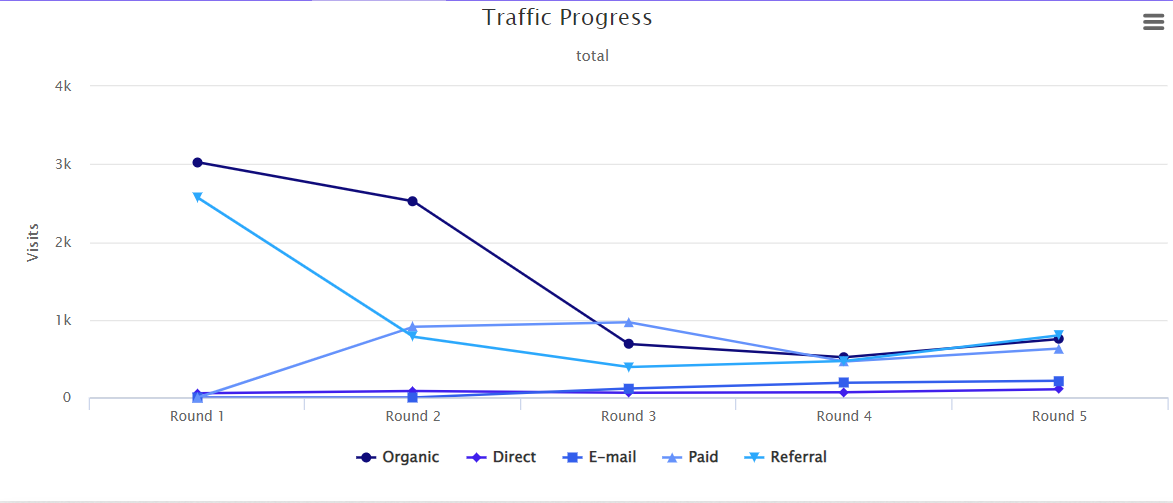Introduction
In the Simbound Game simulation, our team – Tablet.co – was able to test our marketing skills in the area of online advertising while a safe, risk-free environment. In different scenarios, we attempted to promote a website, engaged with search engine campaigns and observed the effect of e-mail advertising. Finally, we supported our marketing efforts with community management activities.
Website Management
In terms of website management, our team has achieved poor results overall. Out of five categories for website popularity – organic, direct, e-mail, paid, and referral traffic – only the e-mail traffic proved to be comparatively reasonable, securing the third position out of seven teams. However, given that e-mail traffic was the category with the lowest contribution to the total traffic, a third place can hardly be considered a success.

In the first round, the Tablet.co website confidently obtained the greatest number of visits. Unfortunately, these visits did not translate into conversions, resulting in roughly 2,5% of conversions out of total visit numbers (Figure 1). For the rest of the rounds, the website failed to repeat its success, scoring the lowest on visits and consistently yielding poor conversion and profit results (Figure 2). The reasons behind the website’s initial popularity might lie in its conciseness and intuitiveness. Nevertheless, a lack of product diversity and poor text placement and design eventually overcame the boom of first impressions and showcased the website’s low long-term stability.

Search Engine Marketing (SEM) Campaign
The performance of SEM turned out to be more promising than the website’s. The strategy of keeping the total costs low (Figure 3) has provided respective results of a relatively low impression rate – 6th position out of seven possible.

Throughout its duration, our SEM campaign yielded a profit in every simulation round. The least significant ROAS was 2,21 in the third round, whereas the best ROAS – 8,16 – was registered in the fifth. In terms of region, the UK campaign that was launched in the later rounds had overall better results than the US campaign prepared for the initial simulation despite the cost similarity (Figure 4). Given that the advertised tablets had the Android OS, the possible implication is that the European market is more friendly toward this platform.

E-Mail Campaign
Regarding the e-mail campaign, it yielded rather ambivalent results. On the one hand, the amount of unsubscribed customers was pleasantly low (Figure 5). Only two out of nine campaigns had a small nonzero value, which can be considered a success. Customer retention is vital in terms of dealing with competition, especially in such contested markets as hand devices.

On the other hand, however, the discount offered in each e-mail campaign proved not worthy of high retention rates. The discount of 30% in the third round brought slight economic losses with minor subscription loss rates. The 40% discount used in the fourth round had six- to ten-times greater losses, slightly elevated the conversion rate, and addressed the customer retention issue completely. However, the discount of 60% attempted in the last round proved fatal in terms of value for the company – the two-times increase in conversion rates was not enough to economically justify three-times value losses.
Community Management
The community management area contained two rounds, where our team introduced a total of six communities – three for each round. In the fourth round, our team introduced an insider community followed by special forums dedicated to product support. In the next round, we provided our customers the ability to create an official company account and created two communities for Tablet.co fans. As a result, both rounds showcased the relatively same members’ engagement of 25% (Figure 6; Figure 7). Given that the last round registered more of our communities but less activity on them, the same engagement rate can be considered a decline.


Conclusion
Overall, the simulation results pointed out many weak links in our marketing skills and knowledge. In terms of website management, we reconsidered the importance of content design and long-term orientation. Regarding SEM, we concluded that there is much more space for risk in terms of budget investment. E-mail campaigns showed us that significant discounts do improve a company’s reputation among customers but can also be of great economic cost. Finally, the community management simulation showcased the value of constant customer engagement.